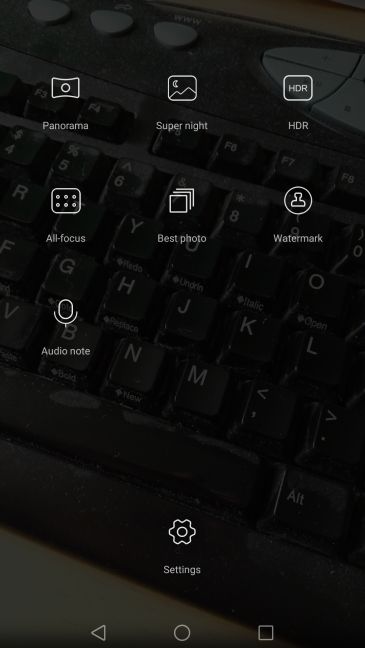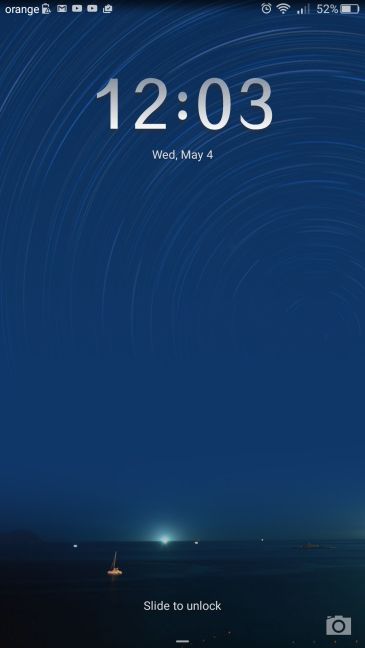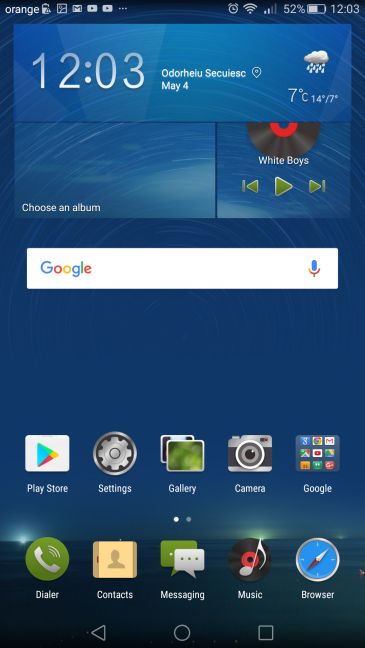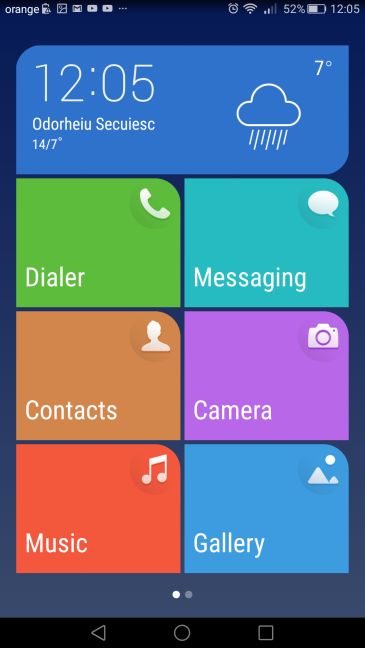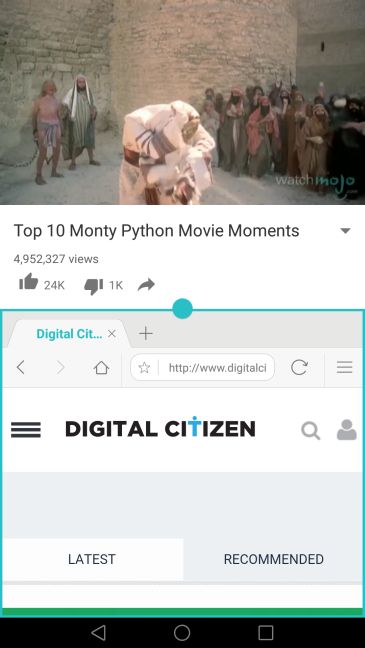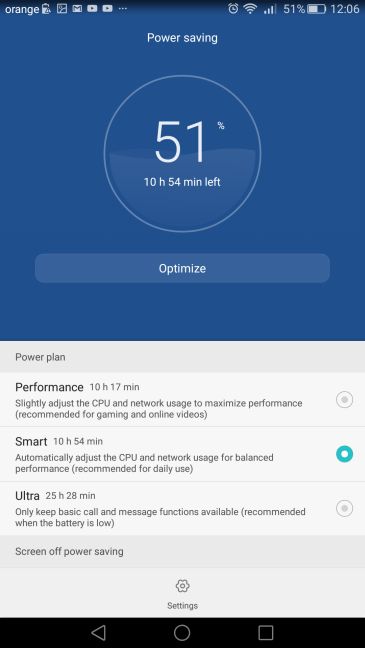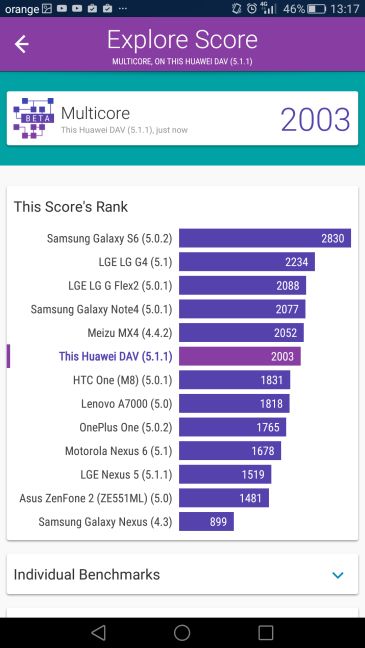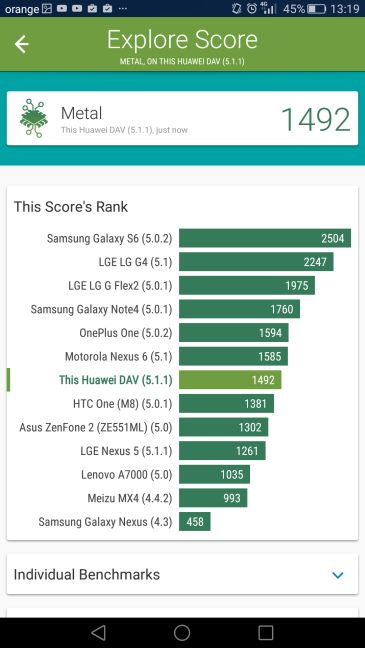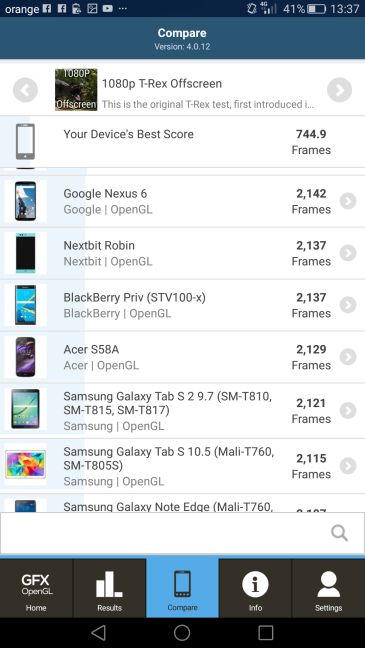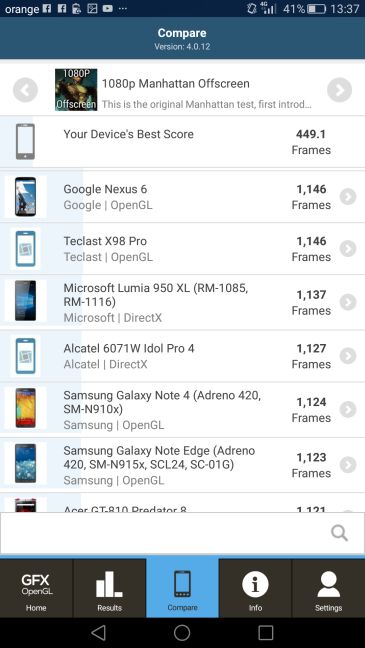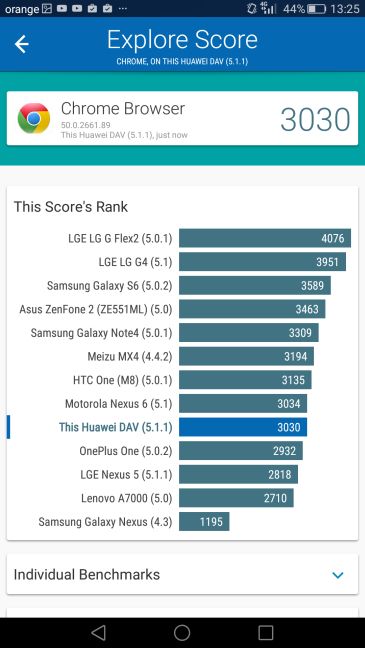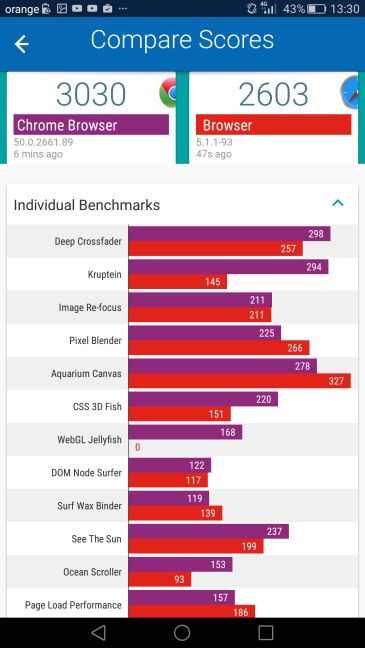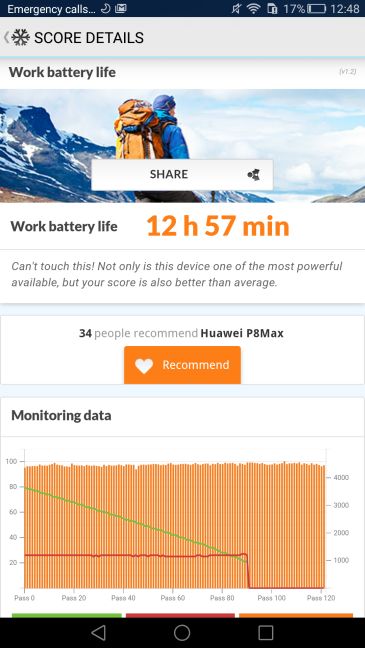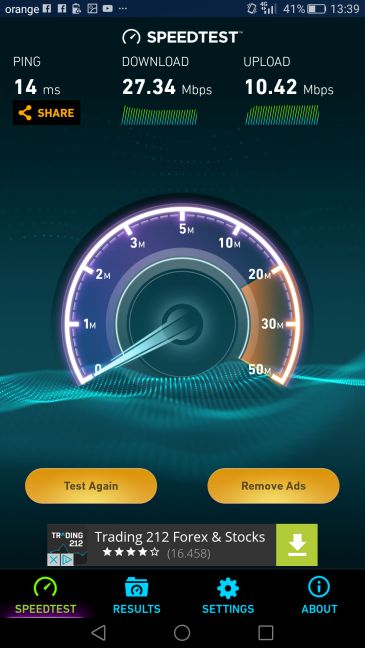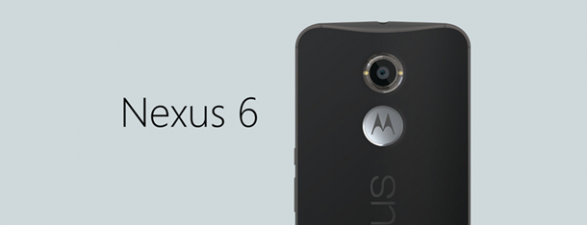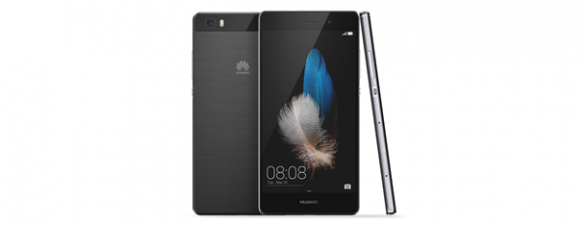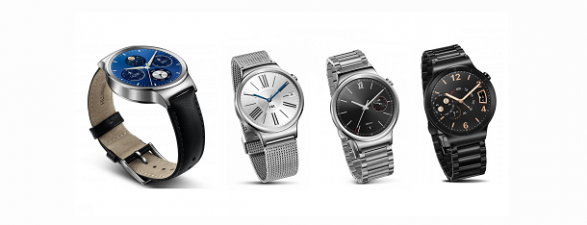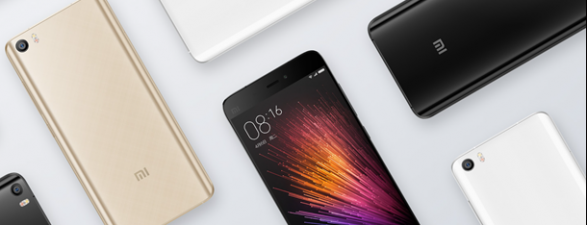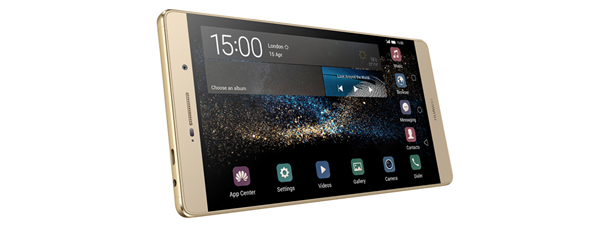
The camera experience on the Huawei P8max
The Huawei P8max is not advertised as a multimedia smartphone, or a camera smartphone. Of course, it has a rather decent camera, but photography is not one of its main selling points. Huawei used a 13 MP camera on the back panel, while the secondary, front-facing camera is a 5 MP module.
The main, 13 megapixel can take pictures at a maximum resolution of 4160 x 3120 pixels and is accompanied by a dual-tone LED flash. Unfortunately, we found no information available about the sensor it uses. The pictures generally have a rather good quality, but the dynamic range is not very high, the colors are a bit faded and contrast is too low, while white parts can get burnt out easily. Still, there isn't a very high level of image noise, details aren't washed out, and we couldn't observe any chromatic aberration either. The secondary camera is mainly used for selfies and, just like on most smartphones, it has a much lower resolution of 5 megapixels. It also has no flash, so stick to the main camera whenever possible.
The camera has some additional features besides the basic camera modes like HDR , Night pictures and Panorama . For example, it lets you take a series of pictures, then choose the best one from them, add watermark to images, or even use audio notes. You can also shoot time-lapse videos, and there is a Beauty mode , which comes in handy when making selfies, as it lets you add beauty effects to the picture - results may vary.
If you have artistic desires, Light painting mode can be your friend: this lets you capture trails of light by using slow shutter speeds. This way you can take pictures of cars with long tail-light, or waterfalls with foamy water. Of course these aren't very good compared to a professional camera, but it can be fun playing around with them.
Using the main camera, you can record videos at a resolution of 1920x1080 pixels at 30 frames per second. The videos are just as average as the photos: they are not bad, or unusable, but they have a low contrast and saturation, and even look a bit like something recorded at a lower resolution, as many details get lost amidst the visible pixels. Still, if you don't have very high expectations, the Huawei P8max will do a fine job in recording family memories and snapshots, but don't expect to shoot the image of your life with this smartphone.
The Huawei P8max is not a camera smartphone. It has an average quality camera, that can take some decent pictures and record okay-ish videos, so if you don't have very high expectations, it will surely do.
Android 5.1.1 Lollipop, EMUI 3.1 & Bundled apps
Huawei P8max ships with Android 5.1.1 Lollipop. There is a planned upgrade to Android 6.0 but at the time we wrote this review, there were no software updates available for this smartphone. Huawei has one of the most highly customized user interfaces, EMUI, and the P8max comes with its 3.1 version.
The EMUI has many modifications, compared to the stock Android experience, one of the most noticeable being the completely modified layout: there is no All apps button, all applications have an icon on the home screen, which has as many pages as you want. Quite iPhone-like, so to say. You can also hide some applications, which can then be accessed by pinching with three fingers on the home screen. The notification panel can be accessed by swiping down from the top, while the quick actions can be accessed by swiping right from this menu. Unfortunately the quick actions cannot be directly accessed from the home screen, you need to do this extra step.
The EMUI is a rather fast and stable user interface that has a minimalistic design, but it also comes with lots of themes: using them you can customize the smartphone's design any way you want, make it simple or very flashy, with lots of animations. The default theme had a strange lock screen, where it was rather hard to unlock the smartphone, as you need to drag across the screen at a very specific location. Fortunately, most themes don't have such a problem, and there a lot to choose from. You can also switch to a simple home screen layout, with large icons if you want.
EMUI has many other small, but rather nice improvements over the default Android operating system. For example, you just need to drag across the three softkeys on the bottom to make the screen smaller - this is really good when you need to use the smartphone with a single hand. Another feature that makes use of the large screen is that you use the apps in split screen mode, you can even resize the two halves.
There is also a floating button feature (called Suspend button ) which makes the main control buttons appear anywhere on the screen - another great feature when using the device with one hand. Smart headset control lets you use your headset's buttons' to issue commands, Smart screenshot lets you take screenshots by knocking the screen and drawing an area to be captured, while Gloves mode comes handy during the winter season, it lets you use the touchscreen while wearing gloves. Other minor features are starting the camera and instantly taking a photo by double-pressing the volume key, muting a call, by putting the phone face down, or answering a call, by holding the smartphone to your ear.
The Huawei P8max comes with a few preinstalled apps, and fortunately, none of them can be considered bloatware. Even if some of them are not very useful, or frequently used, they don't take up much space, so you won't see them as a burden.
The P8max ships with the following bundled applications:
- Calculator - a calculator with advanced features.
- Files - Huawei's file manager.
- HiCare - Huawei's customer support application.
- FM Radio - tune in to local radio stations. It requires a headset to be plugged in.
- Flashlight - activates the rear LED flash that can be used as a flashlight.
- Magnifier - uses digital zoom, but can be useful.
- Mirror - a simple mirror. Blow in the microphone for an easter egg.
- Notepad - a simple note-taking app.
- Phone Manager - a tool for optimizing the performance and the battery life.
- Recorder - a simple voice recorder.
- Weather - Huawei's own weather app and widget.
- WiFi+ - if enabled, the smartphone will monitor the quality of available networks and automatically switch to the network with the best signal and speed.
- WPS Office - a free office suite for Android that supports major document, spreadsheet and presentation formats and has a PDF converter.
Besides these, the Huawei P8max also has all the major Google apps installed, so you don't have to worry about getting them.
The smartphone also comes with HiSuite - Huawei's smartphone companion application that can be installed on a computer in order to connect to the smartphone and manage its contents. Unfortunately, in order to make the smartphone work with HiSuite, you will first need to enable USB debugging in Developer options, which is not very user-friendly and in the latest version of the HiSuite software, these steps are not even mentioned, only in the older one, available from their website.
We are usually very content with the default Android user interface and the experience it provides, but it's always good to see when developers manage to create a user interface that adds to the default experience and improves upon it. EMUI is one such user interface that is really nice to use, easy to configure, has some really neat features and also comes with applications that are almost exclusively good ones and that you will certainly use quite often.
Performance in benchmarks
Yes, the Huawei P8max is a mid-range smartphone, but its design, large screen and really good build quality suggest something more. The benchmark results are a good measure of its qualities so let's see how it fares in them. First we tested the CPU speed, using the popular benchmark application, Vellamo. As always, we were first curious about the multicore performance, so we ran Vellamo's Multicore test, which benchmarks the processor's multithreaded capabilities. The P8max had a score of 2003, which is certainly good, placing it at the top of the mid-range smartphones list, surpassing the HTC One M8, and performing almost as well as the Samsung Galaxy Note 4.
Of course, the multicore performance is not the only relevant measure of a smartphone's speed, since many applications don't even make use of the multi-core CPU, but can only use a single core. In order to check P8max's single-core performance, we ran Vellamo's Metal test, where the smartphone scored 1492 points, again surpassing the HTC One M8, and finishing not far from the Motorola Nexus 6 and the OnePlus One.
Although you might still experience - although infrequent - slowdowns, the scores show that the Huawei P8max is a powerful mid-range smartphone. In terms of CPU speed it is quite similar to some high-end flagship smart phone s.
We need to mention the large screen again: with such a huge display it would be lovely to play some good games, as they are much more fun than on a small smartphone. In order to test graphical performance, we downloaded the GFXBench GL Benchmark and went on to see how the device fares on the T-Rex and Manhattan 1080p tests.
In the T-Rex Offscreen test the Huawei P8max rendered 744.9 frames, which translates to a mere 13 frames per second. This is a very low score, placing the P8max somewhere at the bottom of the performance list. As a comparison, the Google Nexus 6 was more than twice as fast (1146 frames), although it had almost the same performance as the P8max in other benchmarks.
The Manhattan Offscreen test is even more demanding so, naturally, the device had an even lower score of 449.1 frames, or 7.2 fps. These two results show that the Huawei P8max might not be the best choice for high-resolution gaming, as its graphical processing unit is a low-performance one.
In order to test the real-world performance of a smartphone, it is best to have it run everyday tasks, like web browsing, which is one of the main uses of any smart device. Vellamo has a test just for that, called Explore . This test not only tries to render all kinds of content (HTML5, CSS, JavaScript, etc.) in a web browser, but it also measures zooming and scrolling performance - tasks you do all the time when you browse the web. Using Google's Chrome browser, the Huawei P8max received a score of 3030 points, which places it near the top of the benchmark results list, on par with the Nexus 6 and the One M8.
As on many other smartphones, Google Chrome was the fastest on the P8max as well. The smartphone comes with a default browser that had a score of 2603, meaning that if you want to enhance your browsing speed, you might want to stick to Chrome instead of that.
All statistics show that if asked what would they change about their smartphone, the vast majority of responders want better battery life. One might think that the P8max's huge screen will drain the battery quickly, but thanks to the huge, 4360 mAh module and some great energy saving features, we managed to keep the device running for over two days with moderate usage. We have also ran PCMark's Work battery life test to see how does the smartphone fare, and that measured a battery life of 12 hours and 57 minutes, this being benchmarked under constant load and active screen. This makes the Huawei P8max a smartphone with a great battery life - we can only hope that the juice will keep flowing for years, as the battery cannot be replaced by the user.
Since the Huawei P8max is a modern smartphone with 4G LTE support, we have also verified download and upload speeds with Ookla's Speedtest.net application. During our tests we were using the Orange Romania mobile network and measured transfer speeds both indoors and outdoors.
The P8max had no issues connecting to the 4G network, but its speed wasn't exactly top-notch, as we have measured a download speed of 27.34 Mbps and an upload speed of 10.42 Mbps. The ping time was great: just 14 ms. The slightly lower transfer speeds might have been due to traffic congestion on the network, but they were still okay.
We don't think that anyone should make a smartphone purchasing decision by relying purely on synthetic benchmark results, but these should also be considered. In the case of the Huawei P8max it is quite evident that it has a rather powerful hardware, as its CPU fared almost as well as some current flagship, high-end smartphones. Still, it struggles greatly in terms of 3D graphics, as it doesn't have a very high performance graphic chip. If gaming is what you want to use your smartphone for, then you should look elsewhere.
Pros and cons
Regarding the Huawei P8max, its most important pros are:
- It has a minimalistic, elegant design
- It offers good build quality
- The smart cover is very useful and also a high quality accessory
- The smartphone's performance is more than good enough for most tasks
The smartphone has its share of flaws as well:
- It has software bugs that are critical, and should be fixed ASAP
- It doesn't perform well in graphically demanding tasks
- It's price is a bit too much for what it offers
Verdict
With the P8max, Huawei entered the phablet segment of the mobile devices market. The device, being a hybrid of a tablet and a smartphone will surely attract attention to anyone using it: its design is minimalistic, elegant and quite nice, but its sheer size won't go unnoticed. Its physical properties will surely filter the buyers, but if you plan on using it as a multi-purpose work device, then it can be a really good companion.
The Huawei P8max is no gaming device for sure: although its everyday performance is really good, it struggles to deliver a solid gaming experience, due to a poorly performing graphical chip. Its camera is average and can be a good companion on a family trip. It can take reasonably good pictures but don't expect to be featured in National Geographic.
Overall, the Huawei P8max is a good work companion, a likable smartphone that can help you get through your busy day. Its smart cover offers a lovely experience and it might even help the Huawei P8max replace your notebook on some occasions, given its performance, size and battery life. Unfortunately, it has a couple of software bugs that can make your life more difficult, instead of simplifying it. Hopefully, they will get resolved soon.




